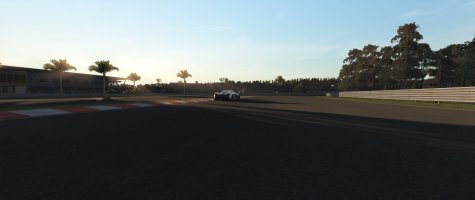Paul Jeffrey
Premium
Time for change with today's presentation of the new 2021 Formula One car and regulations for the future of the sport.
Formula One motor racing is a constantly changing set of complex rules, regulations and interpretations - as has been the case with the sport right from the very first World Championship race at Silverstone almost 70 years ago. With the last few years having seen the introduction of hybrid power, reduced aerodynamic dependency and increased safety measures, often at the cost of on track action, the last few months have seen some intensive research and development by the power people behind Formula One racing - and the results of those investigations have been revealed today - with the presentation of the new for 2021 Formula One car and regulations.
According to F1.com, the key changes for Formula One 2021 style are as follows:
Better looking cars
2021 F1 cars will have a radical new design philosophy and striking new look - with sweeping bodywork, simplified front wings, bigger rear wings, increased underbody aerodynamics, wheel wake control devices, simplified suspension and low-profile tyres with 18-inch rims.
..... LED lights on the wheels.....
Yup, LED lights on the wheels. Because, according to F1, that would be cool. Hmmm. Maybe in a supermarket car park at 12am, but on a race track... I'm less convinced.
Changes that enable closer racing
Though aesthetics were a major consideration, the changes outlined above aren’t just cosmetic – over several years, both Formula 1 and the FIA have been working tirelessly to design cars that can race more closely.
Key to that was finding a solution to the loss of downforce that the current cars experience when running in another car’s wake. Running in dirty air behind another car, a 2019 machine could lose more than 40% downforce. But with the 2021 car design, this drops to around 5-10%, with airflow coming off the new cars both cleaner and directed higher, meaning it has significantly less impact on drivers following, giving them the chance not just to overtake, but to battle.
Fairer Finances
For the first time ever, Formula 1 will introduce spending restrictions to make the sport fairer and more sustainable. A cost cap will be set at $175m per team, per year, and applies to anything that covers on-track performance – but excludes marketing costs, the salaries of drivers, and of the top three personnel at any team.
The F1 cost cap will end the growing spending gap between F1’s big spenders and those with fewer resources, and the on-track performance differential this brings.
Fewer components and more standard parts
In addition to the new financial rules, there are some big changes to the technical and sporting regulations. Rules have been put in place to limit car upgrades over race weekends, and the number of in-season aero upgrades, reducing the costly development arms race that can result in a less competitive grid.
There will also be the introduction of certain standardised parts (such as fuel pumps), parts that must have a prescribed design (such as wheel covers), and increased restrictions on the number of times some components, like brake pads, can be replaced.
Power units remain the same as now, but exhaust systems have been added to the list of PU components that are limited in number per season, with each driver able to use six before penalty.
Cars will 25kg heavier as a result of the new tyres, changes in chassis and PU materials to save costs, further safety measures and the introduction of standardised and prescription parts. That will make cars slower than now to begin with.
Gearbox design will be more restricted, with configurations frozen to save research and development costs. Tyre blankets, meanwhile, will not be scrapped as once proposed, instead remaining for 2021 and 2022, albeit with restrictions.

Revised race weekends
There will also be small but significant changes to the race weekend structure, which will be condensed, in order to improve the fan experience and help teams deal with an expanded calendar, with the maximum number of races in a season now 25.
The pre-race press conference will be switched from Thursday to Friday, ahead of the first and second practice sessions, while cars will now be in parc ferme conditions (i.e. in race trim) from the start of FP3.
FP3 also marks the point at which the teams must return their cars to the ‘reference specification’ presented for scrutineering before FP1, so any bodywork trialled in practice must be removed.
Furthermore, all teams must run at least two practice sessions during the year using drivers who have completed two Grands Prix or fewer – giving more chance for the next generation to shine.
Less wind tunnel testing
In a further bid to reduce aero development costs, the number of wind tunnel runs teams can do each week has been slashed, with emphasis put on using CFD (Computational Fluid Dynamics) simulations over physical ones.
Other rules play into this. For example, the switch to low-profile tyres isn’t purely aesthetic. The high-profile tyres used in F1 at the moment tend to move around and deflect a lot, which has an impact on aerodynamics. The teams with the biggest budgets are able to look at these effects in detail and are better able to deliver solutions that give them an edge over others. A tyre with a stiffer side wall doesn’t move as much, simplifying the aerodynamics and thus reducing development investment.
So, plenty happening in the near future for Grand Prix fans. You can check out the full article on F1.com HERE.
If you like F1 racing, head over to the Formula One sub forum here at RaceDepartment to stay in touch with the sport, and your fellow Grand Prix fans.
Like what we do at RaceDepartment? Spread some love and give us a like/follow/share on Social Media!
Podcast fan? Don't forget to catch up with the latest happenings on your Podcast platform of choice! Just search 'RaceDepartment'.
Sim Racing is awesome!
Formula One motor racing is a constantly changing set of complex rules, regulations and interpretations - as has been the case with the sport right from the very first World Championship race at Silverstone almost 70 years ago. With the last few years having seen the introduction of hybrid power, reduced aerodynamic dependency and increased safety measures, often at the cost of on track action, the last few months have seen some intensive research and development by the power people behind Formula One racing - and the results of those investigations have been revealed today - with the presentation of the new for 2021 Formula One car and regulations.
According to F1.com, the key changes for Formula One 2021 style are as follows:
Better looking cars
2021 F1 cars will have a radical new design philosophy and striking new look - with sweeping bodywork, simplified front wings, bigger rear wings, increased underbody aerodynamics, wheel wake control devices, simplified suspension and low-profile tyres with 18-inch rims.
..... LED lights on the wheels.....
Yup, LED lights on the wheels. Because, according to F1, that would be cool. Hmmm. Maybe in a supermarket car park at 12am, but on a race track... I'm less convinced.
Changes that enable closer racing
Though aesthetics were a major consideration, the changes outlined above aren’t just cosmetic – over several years, both Formula 1 and the FIA have been working tirelessly to design cars that can race more closely.
Key to that was finding a solution to the loss of downforce that the current cars experience when running in another car’s wake. Running in dirty air behind another car, a 2019 machine could lose more than 40% downforce. But with the 2021 car design, this drops to around 5-10%, with airflow coming off the new cars both cleaner and directed higher, meaning it has significantly less impact on drivers following, giving them the chance not just to overtake, but to battle.
Fairer Finances
For the first time ever, Formula 1 will introduce spending restrictions to make the sport fairer and more sustainable. A cost cap will be set at $175m per team, per year, and applies to anything that covers on-track performance – but excludes marketing costs, the salaries of drivers, and of the top three personnel at any team.
The F1 cost cap will end the growing spending gap between F1’s big spenders and those with fewer resources, and the on-track performance differential this brings.
Fewer components and more standard parts
In addition to the new financial rules, there are some big changes to the technical and sporting regulations. Rules have been put in place to limit car upgrades over race weekends, and the number of in-season aero upgrades, reducing the costly development arms race that can result in a less competitive grid.
There will also be the introduction of certain standardised parts (such as fuel pumps), parts that must have a prescribed design (such as wheel covers), and increased restrictions on the number of times some components, like brake pads, can be replaced.
Power units remain the same as now, but exhaust systems have been added to the list of PU components that are limited in number per season, with each driver able to use six before penalty.
Cars will 25kg heavier as a result of the new tyres, changes in chassis and PU materials to save costs, further safety measures and the introduction of standardised and prescription parts. That will make cars slower than now to begin with.
Gearbox design will be more restricted, with configurations frozen to save research and development costs. Tyre blankets, meanwhile, will not be scrapped as once proposed, instead remaining for 2021 and 2022, albeit with restrictions.
Revised race weekends
There will also be small but significant changes to the race weekend structure, which will be condensed, in order to improve the fan experience and help teams deal with an expanded calendar, with the maximum number of races in a season now 25.
The pre-race press conference will be switched from Thursday to Friday, ahead of the first and second practice sessions, while cars will now be in parc ferme conditions (i.e. in race trim) from the start of FP3.
FP3 also marks the point at which the teams must return their cars to the ‘reference specification’ presented for scrutineering before FP1, so any bodywork trialled in practice must be removed.
Furthermore, all teams must run at least two practice sessions during the year using drivers who have completed two Grands Prix or fewer – giving more chance for the next generation to shine.
Less wind tunnel testing
In a further bid to reduce aero development costs, the number of wind tunnel runs teams can do each week has been slashed, with emphasis put on using CFD (Computational Fluid Dynamics) simulations over physical ones.
Other rules play into this. For example, the switch to low-profile tyres isn’t purely aesthetic. The high-profile tyres used in F1 at the moment tend to move around and deflect a lot, which has an impact on aerodynamics. The teams with the biggest budgets are able to look at these effects in detail and are better able to deliver solutions that give them an edge over others. A tyre with a stiffer side wall doesn’t move as much, simplifying the aerodynamics and thus reducing development investment.
So, plenty happening in the near future for Grand Prix fans. You can check out the full article on F1.com HERE.
If you like F1 racing, head over to the Formula One sub forum here at RaceDepartment to stay in touch with the sport, and your fellow Grand Prix fans.
Like what we do at RaceDepartment? Spread some love and give us a like/follow/share on Social Media!
Podcast fan? Don't forget to catch up with the latest happenings on your Podcast platform of choice! Just search 'RaceDepartment'.
Sim Racing is awesome!










